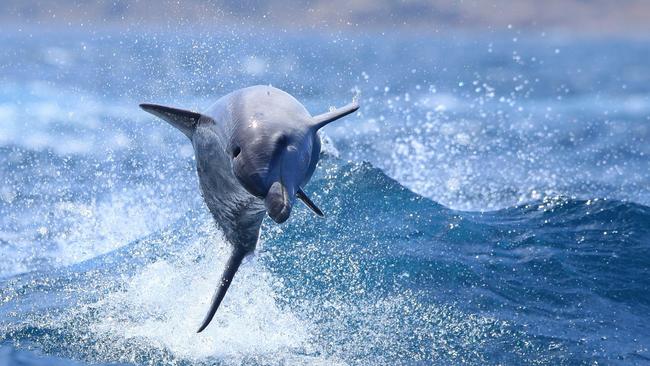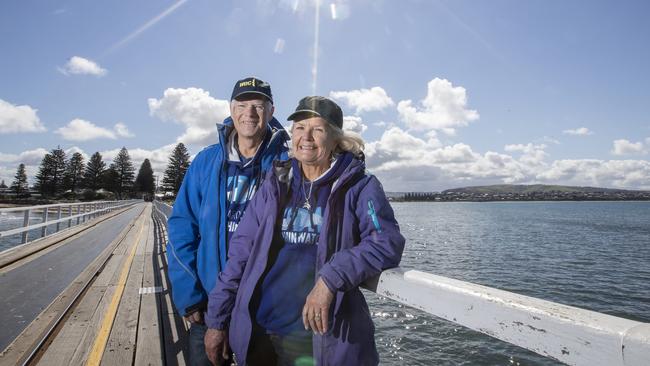Dolphin Watch couple inspires a new breed of ocean guardians in Victor Harbor and Kangaroo Island
Dolphin Watch volunteers have lobbied against oil drilling in the Great Australian Bight and recorded endless data on the cetaceans’ health and habitat, but say one of their most valuable achievements is instilling in others the desire to protect the ocean.
- KI seaport plan sparks concern about whales, dolphins
- Marine park sanctuary zones in focus to help protect dolphins
They have lobbied against oil drilling in the Great Australian Bight, for lower boat speeds and against plans for a seaport on Kangaroo Island – all in the name of protecting our dolphins and whales.
But Tony and Phyll Bartram count fostering the next generation of ocean guardians as one of their most valuable achievements during 14 years with Dolphin Watch.
The Kangaroo Island-based couple set up the organisation in 2005, expanding it to Victor Harbor six years later.
This month, they celebrated the group’s 100th survey from the South Coast tourist hub, inviting The Advertiser along for the ride.
Phyll says when the couple started the group, the sense of “doom and gloom” about the state of the environment was “all consuming”.
“It still is, but now we’re doing something to try and help,” she says.
“It’s quite life changing for volunteers because we can all make a difference.
“It’s pretty special to be able to live in a beautiful environment like this and we need to look after it and protect it.”

This month’s trip features a trip to the Pages Islands in Encounter Marine Park to see their resident Australian sea lions – one of the world’s rarest sea lion species.
There are estimated to be about 10,000-12,000 Australian sea lions in Australia, with 80 per cent living in SA.
As The Big Duck smashes through the waves southwest of Victor Harbor, volunteers on board the boat are quick to point out the bottlenose and short-beaked common dolphins swimming just below the water’s surface and leaping into the air – sometimes in groups of twos and threes.
Dolphin Watch identifies the dolphins by their dorsal fins, takes measurements of the water and air temperature and observes their habitat to look for links between the environment and the cetaceans’ behaviour.
Sometimes, the Bartrams say a trip on the ocean brings joyful occasions such as seeing new calves or signs of populations swelling.

But so too, have there been emotional days out on the water.
Phyll recalls an encounter with bottlenose dolphin Tiki, who was surrounded by a large pod while carrying what looked like a large fish in her mouth.
“As we got closer we realised she was a female and holding a dead calf,” Phyll says.
“All the dolphins were escorting her along. It was just beautiful. We were all in tears.”
Tony says another eye opening moment came when the team saw a dolphin teaching her calf how to safely kill and eat a sting ray.

“That was the first time we’re aware of that a dolphin was seen eating a sting ray,” he says.
“It could be that they’re trying to adapt to different prey species.”
Kangaroo Island/Victor Harbor Dolphin Watch aims to give people an appreciation for the ocean and all of the species that call it home.
It also advocates for the animals to try and ensure they’re not left the worse off as a result of human activity.
That includes lobbying for measures to protect sea animals from the potential consequences of oil and gas exploration in the Great Australian Bight.

“We started eight or nine years ago and at this stage they’re not out there yet – I suppose that’s an achievement in its own right,” Tony says.
“We don’t do heavy activism. We work with the industry and try to do it negotiation, consultation and education.”
The couple is also lobbying against Kangaroo Island Plantation Timbers’ plans to build a seaport at Smith Bay – a project they say would be “a game changer” for dolphins and whales.
Diminished water quality, sea grass loss and stress caused by construction and operations of the port are among the group’s concerns over the project, which is awaiting State Government assessment.
AUSTRALIAN SEA LIONS AT RISK
■ There are estimated to be about 10,000-12,000 Australian sea lions in Australia. It is the only sea lion species in the country.
■ About 80 per cent of the population lives in SA.
■ Sea lions are found at Kangaroo Island, the Eyre Peninsula and offshore islands, including The Pages, which features two small islands and a reef in Backstairs Passage.
■ The last statewide surveys of breeding sites were done in 2014-15. The Environment Department says data from the 32 sites showed an estimated 24 per cent decline in the population, compared with 6-11 years earlier.
■ Sea lions were hunted in the early 1800s, and the population has not recovered since. The animals are also threatened by large mesh gill net commercial fishing operations, marine debris and disease.
■ The species is also vulnerable because females do not mature until aged six years and breed on an 18-month cycle rather than once a year.
michelle.etheridge@news.com.au
